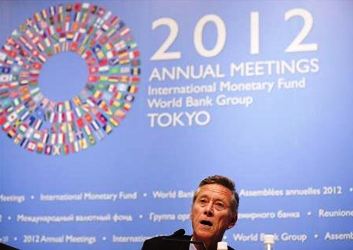IMF revises Sudan’s 2012 GDP downwards
October 9, 2012 (WASHINGTON) – The International Monetary Fund (IMF) on Tuesday revised its outlook for the Sudan economy showing a worst than projected economic contraction for 2012.

“Sudan, which remains in the Middle East and North Africa region, is now classified as a country with nonfuel primary products as the main source of export earnings,” the IMF report reads.
The east African nation was almost totally reliant on oil exports which provided the bulk of its national income and foreign currency inflows fueling an economic boom that followed the end of a two-decade long civil war.
After years of a robust economic growth including double-digit figures, Sudan witnessed an economic contraction in 2011 as a direct result of the country’s breakup.
Last April, the IMF projected a -7.3% GDP contraction in Sudan for 2012 but today the world financial institution changed that number to -11.2%.
Next year the IMF estimates that the slide in Sudan’s GDP figures will come to a halt to be at a 0% rate. This contrasted with the -1.5% forecast made by the IMF in its first World Economic outlook report this year.
The report does not reflect the oil deal signed last month between north and south Sudan which sets the price by which the landlocked south could transport its oil using the north’s pipelines that extend to export terminals in Port Sudan.
South Sudan will pay between $9.10 and $11 a barrel to export its crude through the north. Juba will also pay a lump sum $3.08 billion to help Sudan overcome the budget deficit resulting from the south’s secession.
Sudan’s 2012 budget was drawn with the assumption of being paid $36 per barrel of oil exported by South Sudan. Juba however objected to the fee causing a dispute that resulted in suspending oil production altogether earlier this year.
It remains to be seen what the financial impact of the deal will be given the Sudan’s struggle with a widening fiscal gap, deteriorating exchange rate of the Sudanese pound against other currencies, hefty external debt and lack of access to international financing.
Last summer Sudan adopted the first phase of an austerity package which involved partially lifting food and fuel subsidies as well as cutting spending by reducing the size of the government. However, the Sudanese finance minister Ali Mahmood Abdel-Rasool recently suggested that more cuts will be needed to bring the fiscal situation under control.
Last month the International Monetary Fund (IMF) called on Sudan to initiate further reforms including reforming the civil service and continue the privatization program.
(ST)
